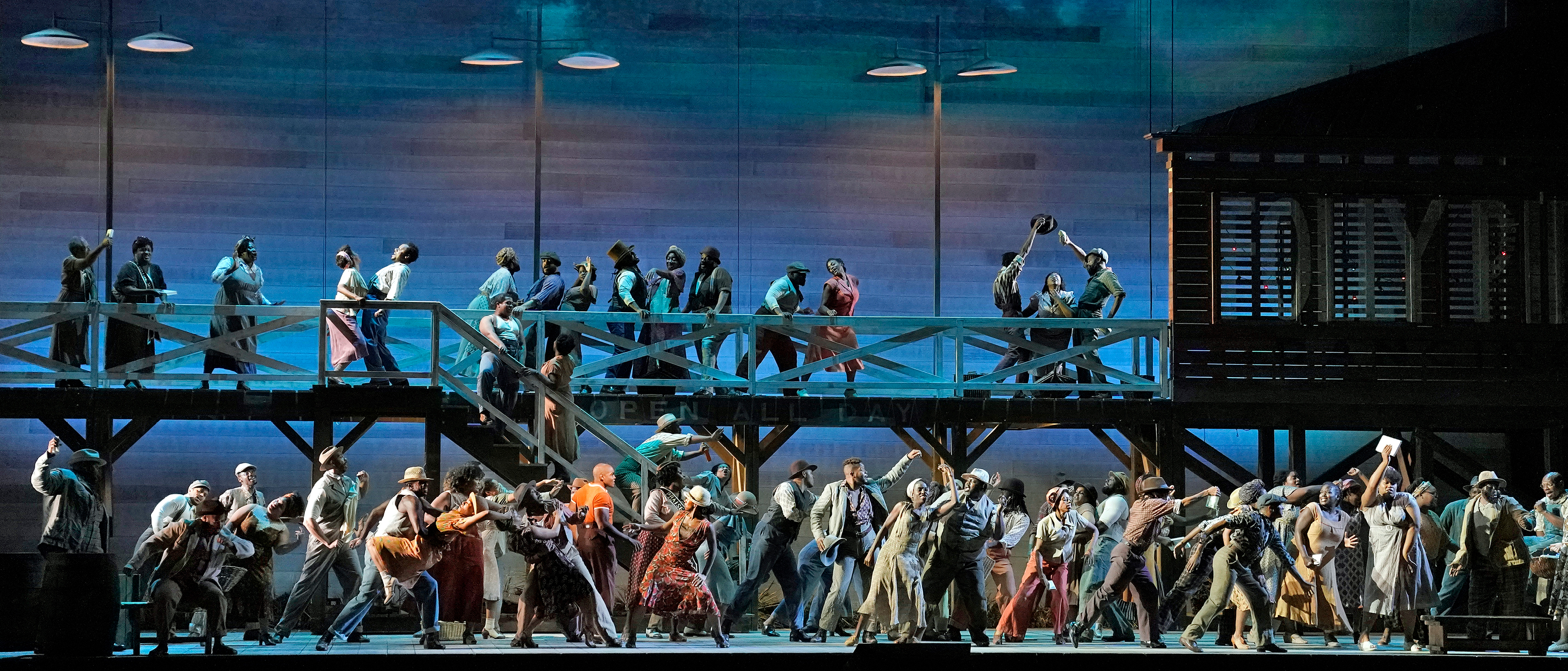
From Commercial Theater to the Met
For 25 years after the opening season of the new Metropolitan Opera House at Lincoln Center, the company gave no world premieres. However, American works first heard in New York’s vibrant theater world were added to the company’s repertory. Most notable was the long-awaited Met premiere of George Gershwin’s Porgy and Bess. In addition, Virgil Thomson’s Four Saints in Three Acts was performed in an adjunct season by the Mini-Met, while émigré composer Kurt Weill’s Rise and Fall of the City of Mahagonny was produced on the Met’s main stage as part of the regular season.
Virgil Thomson’s Four Saints in Three Acts
Four Saints in Three Acts, Virgil Thomson’s pathbreaking collaboration with Gertrude Stein, was presented in 1973 at the Mini-Met, a short-lived project that performed small-scale productions at Lincoln Center’s intimate Forum Theater (now the Mitzi Newhouse Theater). Choreographer Alvin Ailey directed an all-Black cast honoring the work’s historic premiere production that played successfully on Broadway in 1934.
Virgil Thomson’s Four Saints in Three Acts, with Hilda Harris, Arthur Thompson, and Clamma Dale, at the Forum Theater, 1973.
Photo: Metropolitan Opera Guild
Left: Alvin Ailey, director of Four Saints in Three Acts, with cast members Clamma Dale and Hilda Harris.
Photo: Louis Mélançon
Right: Composer Virgil Thomson bows with the cast of Four Saints in Three Acts, 1973.
Photo: Louis Mélançon
Kurt Weill’s Rise and Fall of the City of Mahagonny
After revolutionizing the Weimar Republic theater of his native Germany, Kurt Weill built a notable Broadway career, acquiring American citizenship in 1943. His 1929 collaboration with Bertolt Brecht in German, Aufstieg und Fall der Stadt Mahagonny, was heard off-Broadway in 1970, in English translation. Not technically an American opera, Weill’s Rise and Fall of the City of Mahagonny nevertheless has strong American influences and premiered at the Met in English, in 1979. Audience reaction was mixed, as nothing remotely similar in style had ever been part of the Met repertory. John Dexter, the company’s Director of Productions, created a strong theatrical production, while Music Director James Levine led a compelling performance starring the charismatic Teresa Stratas as Jenny.
Left: Teresa Stratas as Jenny in Rise and Fall of the City of Mahagonny, 1979.
Photo: Winnie Klotz
Right: Kurt Weill’s Rise and Fall of the City of Mahagonny, 1979, starred Teresa Stratas.
Photo: James Heffernan
The Gershwins’ Porgy and Bess
By far the most popular and most performed American opera, George Gershwin’s Porgy and Bess premiered on Broadway in 1935 but did not have its Met premiere until half a century later in 1985. Otto Kahn had negotiated with Gershwin for a Met premiere, but as Ira Gershwin noted years later, “George was greatly flattered … but finally felt that for the Met to acquire an all-Negro cast to be available six to eight performances a season, was not too practical a project.”
Starring American singers Simon Estes and Grace Bumbry in the title roles, Porgy and Bess played to sold-out houses at the Met in 1985 and solidified its iconic status in the American opera repertory. A new production in 2019 with Eric Owens and Angel Blue again proved the work’s popularity with audiences and made it the only American opera in Met history to receive more than one production. With a total of 71 performances to date, Porgy and Bess is the most frequently played American opera at the Met.
Porgy and Bess, 2019. Production by James Robinson, set designs by Michael Yeargan, costume designs by Catherine Zuber.
Photo: Ken Howard
Left: Angel Blue and Eric Owens in Porgy and Bess, 2019.
Photo: Ken Howard
Right: Simon Estes and Grace Bumbry in Porgy and Bess, 1985.
Photo: Metropolitan Opera Guild
European Voices
In addition to Kurt Weill, several leading international composers sought refuge in the United States from the calamitous 20th century upheavals in Europe. For the most part, their operas were composed prior to emigrating and retained primarily European artistic sensibilities. The Met has performed a number of works by such émigrés, notably Erich Korngold (Die Tote Stadt, 1921), Ernst Krenek (Jonny Spielt Auf, 1929), and Arnold Schoenberg (Erwartung, 1989; Moses und Aron, 1999). Among this group, Igor Stravinsky was exceptional by any measure and changed styles radically throughout a long and distinguished career. Of his early works, the Met gave the ballets Petrouchka (1919) and Apollon Musagète (1938), and the U.S. premiere of the opera Le Rossignol (1926). Rudolf Bing welcomed Stravinsky to the Met for the 1953 American premiere of The Rake’s Progress, with a scenario by poet W. H. Auden based on 18th-century William Hogarth paintings. By then an American citizen and the world’s most famous living composer, Stravinsky was accorded star treatment: Fritz Reiner conducted a production directed by renowned choreographer George Balanchine in one of the New York season’s most anticipated events. The Rake’s Progress was given a new staging in 2003, directed by Jonathan Miller and conducted by James Levine—a production that returns to the stage this season.
In 1981, the Met presented a Stravinsky triple bill of early–20th-century classics that revived Le Rossignol after more than a half century, framed by the opera-oratorio Oedipus Rex and the iconic ballet Le Sacre du Printemps.
Igor Stravinsky’s The Rake’s Progress
Igor Stravinsky: The Rake’s Progress, 1953. Left to right: Hilde Güden, Blanche Thebom, and Paul Franke
Photo: Sedge Leblang
Left: Stravinsky rehearsing The Rake’s Progress with Hilde Güden, 1953.
Photo: Sedge Leblang
Right: The Rake’s Progress: Rehearsal, 1953. Left to right: Met assistant conductor Max Rudolf, conductor Fritz Reiner, composer Igor Stravinsky, and director George Balanchine.
Photo: Sedge Leblang
Searching for an American Style
American Commissions and Beyond
From Commercial Theater to the Met